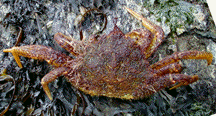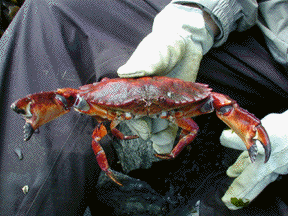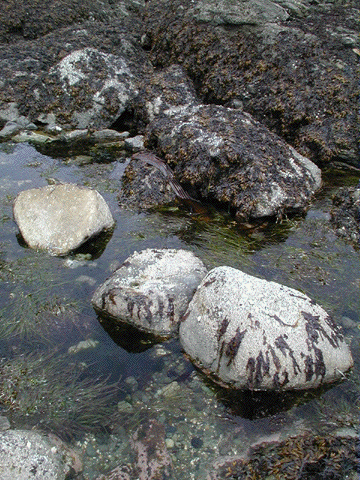Handy Joe's Crab Den
Much of the pool is covered with surf grass, and many of the large rocks have rockweed (Fucus) growing along their sides. With abundant plant cover and numerous rocks throughout the pool, Handy Joe's is an ideal setting for crabs. If you move some surf grass or lift a rock, you're almost certain to see a hermit crab, huddled in a snail shell or other cover, scurrying about the bottom of the pool. Larger crustaceans, such as red crabs and helmet crabs, may also be found beneath rocks or in crevices that edge the pool.
All organisms that live in tide pools must withstand great changes in their environment. As the ocean rises and falls twice a day, tide pools vary in temperature and salinity, and local residents have to learn to adapt to these changes. In the course of a day, the salinity may rise from 29.5 parts per thousand (ppt) to 36 ppt. Temperatures also fluctuate, from 11 degrees C to 16 degrees in early July. Using a temperature data logger, we collected 48 hours of temperature fluctuations in the pond:
To get an idea of just how much diversity can be found in a small area of this pond, we used a quadrant (a measured square, in our case 0.25 square meters or just over 3 square feet) to count the number of animals in the center of the pond. We found:
500 spiral tube worms (Spirorbis spp.)

15 limpets (Patellacea)
7 hermit crabs (Pagurus spp.)
4 bryozoan colonies (Membranipora membranacea)
2 acorn barnacles (Semibalanus cariosus)
2 top-shell snails (Calliostoma spp.)
1 isopod (Isopoda)
1 clam worm (Nereis virens)
1 dogwinkle (Nucella sp.)
1 bread-crumb sponge (Halichondria panacea)
1 decorator crab (Oregonia gracilis)
1 hairy chiton (Mopalia sp.)
With so many species at Handy Joe's, it's clear why tide pools have been so important in the ecology of shoreline areas. Ecologists have studied basic principles of competition and predation in these areas for decades. As in any community, there are antagonisms and alliances. Many species have developed strong defenses against invaders or would-be predators.
Looking at a kelp blade, one might see a roughened patch. This is actually a colonial organism, a bryozoan, with hundreds of genetically identical units, or zooids. If one zooid dies, the colony can replace it. And if the lophophores, which resemble little palm trees, are under threat, all the zooids will retract simultaneously, to avoid further attack.
 There
are more conventional forms of protection here: spiral tube worms, helmet
crabs, and barnacles use calcareous plates to fend off attack. This armor
is strong enough to repel many hungry predators. But sometimes, the best
defense is a strong offense, and though crabs will almost never attack
if unprovoked, a curious finger placed too close to waiting claws will
prompt a viscous nut-cracker squeeze from the large front claws, or chelipeds.
There
are more conventional forms of protection here: spiral tube worms, helmet
crabs, and barnacles use calcareous plates to fend off attack. This armor
is strong enough to repel many hungry predators. But sometimes, the best
defense is a strong offense, and though crabs will almost never attack
if unprovoked, a curious finger placed too close to waiting claws will
prompt a viscous nut-cracker squeeze from the large front claws, or chelipeds.
Though the barnacle can protect itself from wave action
and many predators with its hard calcium carbonate shell, it still falls
prey to the small whelk, Nucella. This marine snail that can drill
a hole through hard barnacle shell plates using its radulla, a toothlike
structure made of chitin. Once the hole is complete Nucella secretes
a toxin which stuns the barnacle. The snail then inserts its proboscis
between the plates and sucks the guts right out of the shell.
Species you might find while visiting Handy Joe's Crab Den include:
- Dogwinkle, (Nucella spp.)
- Hairy chiton (Mopalia spp.)
- Helmet crabs (Crytpolithodes spp.)
- Hermit Crab (Pagurus spp.)
- Keyhole Limpet (Diodora aspera)
- Leather chiton (Katharina tunicata)
- Orange sea cucumber (Cucumaria miniata)
- Porcelain crab (Petrolisthes eriomerus)
- Red crab (Cancer productus)
- Shore crabs (Hemigrapsus nudus, Hemigrapsus oregonensis)
- Spider crabs (Pugettia gracilis)
- Spiral tube worms (family Spirorbidae), up to 90% coverage of some rocks
- Stiff-footed sea cucumber (Eupentacta quinquesemita)
- Anemone (Urticina crassicornis)



 Home
Home